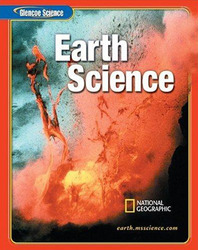1.
A) They believe the movement of material inside Earth's core along with Earth's rotation generates a magnetic field. B) They believe the movement of material inside Earth's core generates a magnetic field. C) They believe Earth's tilted axis along with Earth's rotation generates a magnetic field. D) They believe the Earth's revolution around the Sun generates a magnetic field. 2.
A) new moon B) waning crescent C) waxing crescent D) waxing gibbous 3.
A) tilted away from the Sun B) lined exactly perpendicular to the Sun C) tilted toward the Sun D) closer to the Sun 4.
A) because of the discovery of volcanoes on the Moon's surface B) because of the discovery of maria on the Moon's surface C) because of the discovery of hydrogen on the Moon's surface D) because of the discovery of water on the Moon's surface 5.
A) the impact theory B) the theory that Earth ejected a blob of molten material that formed the Moon C) the capture theory D) the theory that loose material around Earth condensed to produce the Moon 6.
A) third quarter moon B) waxing crescent C) a lunar eclipse D) a solar eclipse 7.
A) Rotation refers to Earth's spinning on its axis, and revolution refers to Earth's spinning around the Sun. B) Rotation refers to Earth's spinning on its equator, and revolution refers to Earth's spinning around the solar system. C) Revolution refers to Earth's spinning on its axis, and rotation refers to Earth's spinning around the Sun. D) Revolution refers to Earth's spinning on its axis, and rotation refers to Earth's changing seasons. 8.
A) because Earth's atmosphere changes the color of the Sun's light B) because the Moon receives direct sunlight from the Sun during a lunar eclipse. C) because Earth's atmosphere intensifies the Sun's light onto the Moon D) because Earth's atmosphere bends the Sun's light onto the Moon 9.
A) Earth's orbit is an ellipse - an elongated, closed curve - so the distance sometimes changes. B) Earth's orbit is an ellipse - an elongated, closed curve - but the change in distance from the Sun is only an optical illusion. C) Earth's orbit is a circle, so the distance never changes. D) Earth's orbit is a circle, so the distance sometimes changes. 10.
A) a year B) eclipses C) day and night D) the seasons 11.
A) the amount of time it takes the Moon to revolve B) the amount of time it takes for Earth to rotate C) the amount of time it takes for Earth to revolve D) the amount of time it takes the Moon to rotate 12.
A) Earth's axis is the imaginary vertical line that separates the eastern and western hemispheres. B) Earth's axis is the imaginary line around which Earth spins. C) Earth's axis is the imaginary horizontal line that separates the northern and southern hemispheres. D) Earth's axis is the imaginary line around which Earth spins around the Sun. 13.
A) comets B) asteroids C) meteorites D) all answers are correct 14.
A) the Moon, Earth's B) Earth, the Sun's C) the Sun, Earth's D) Earth, the Moon's 15.
A) The change in distance is actually minimal. Earth's tilted axis is the real cause of seasons on Earth. B) Even though Earth's orbit is an ellipse, the change in distance from the Sun is only an optical illusion. C) The change in distance occurs at the same time as the seasons, so we don't notice the change. D) The change in distance is the real cause of seasons on Earth. 16.
Clementine bring back about the Moon?A) The crust on the side of the Moon facing Earth is thinner than the other side. B) information for a global map of the Moon C) all answers are correct D) There is ice on one portion of the Moon, which would be ideal for a Moon colony. 17.
A) waxing gibbous B) full moon C) waning crescent D) new moon 18.
A) During an equinox, the northern hemisphere is tilted closer to the Sun. B) During an equinox, the seasons switch, and instead of occurring at the same time, they occur opposite each other. C) During the rest of the days of the year, Earth is tilted, and each hemisphere experiences opposite seasons. D) During an equinox, the southern hemisphere is tilted closer to the Sun. 19.
A) new moon B) waning crescent C) waxing gibbous D) waning gibbous 20.
A) the seasons B) the point at which the Sun reaches its greatest distance east or west of the prime meridian C) the point at which the Sun reaches its greatest distance north or south of the equator D) the point at which the Sun is closest to Earth














